Video games cover a wide range of emotions. From Ni No Kuni 2, which promotes forgiveness and unity, to Hellblade: Senua’s Sacrifice, which delves into psychological horror and psychosis, as a storytelling medium video games can be full of joy or darkness. While the happy games are fun, it’s the dark and twisted stories that hit us like tons of bricks. Sometimes they sit in our heads for weeks or change the way we look at the world. Sometimes they thrill us. Sometimes they break our hearts.
Sometimes they’re just really, really messed up.
Be aware: beyond here lies spoilers.
The Botchling – The Witcher 3
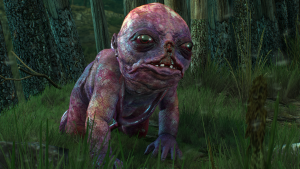
The Witcher series is violent and full of monsters and haunting imagery – by which I mean it makes us shout profanity at our TVs and hit the screen share button faster than we’ve ever hit it in our lives to make sure our friends are as amused/horrified as we are. The best example lies in the first major storyline in The Witcher 3 – a story that covers domestic abuse, cannibal witches and oh, yeah, a flying miscarried fetus monster.
Domestic violence is a scary enough issue on its own merits. Geralt’s magically powered and detective-worthy forensic investigation into the disappearance of the Bloody Baron’s wife not only brings us face-to-face with a man who beats his spouse, the game attempts to present it in an almost sympathetic way. She brought it on herself by cheating, the Bloody Baron says. She picked the fights, it was an accident, I didn’t mean to get so mad. It culminates in a particularly horrifying retelling of the night the Bloody Baron beat his wife so hard she miscarried. She fled for her life, making a pact with pure evil just to escape. The Baron buried the mangled corpse of his infant daughter in a ditch, causing her to rise at night and murder innocent people.
The only saving grace in this mess? Geralt can tell the baron exactly what he thinks of men who beat their wives.
The Story of Tiny Tina’s Parents – Borderlands 2
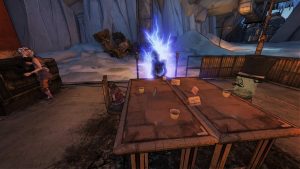
When we first meet Tiny Tina (the deadliest 13-year old around), she’s electrocuting the bandit who murdered her parents. It’s one of the best character introductions in the franchise: weird, violent and strangely endearing. Fans of the lore of Borderlands know that’s just the beginning of the story.
One of the side quests Tannis gives out, Doctor’s Orders, asks players to collect ECHO data on slag experimentation done at the Wildlife Exploitation Preserve. The side quest pops up around the time the main story quest has players rescuing Bloodwing, so it’s easy to blow through without really listening. The ECHO data tells the story of a family abducted by a bandit and handed over to Handsome Jack for eridium experimentation. Over the four recordings we hear Handsome Jack force a doctor to torture a married couple – sometimes while the daughter listens. At the very end, the mother helps the daughter escape certain death by use of a grenade hidden in the daughter’s dress.
So not only did Jack order the torture and death of Tiny Tina’s parents, she saw it all go down.
You’re The Villain – Braid

The “Surprise! You’re actually the villain!” story has been done before, and by franchises like Bravely Default (don’t listen to the fairy, guys. Just don’t). Braid, the little indie game that could, puts you in a Mario-like platformer and instructs you to go save the princess from a monster.
The problem? You’re not saving her. You are the monster.
In the grand tradition of unreliable narrators (or films that play with time – the most famous comparison is Memento), Braid takes everything that makes video games sweet and innocent and turns it around on the player. After hours of ever-increasing trickery from the game’s mechanics, beating the final level should feel like a victory. What you get, instead, is a rug-pull that leaves players almost winded. The end of Braid is still a matter of discussion, and famously left open to interpretation by the game’s creator, Jonathan Blow.
Join Citra or Save Your Friends – Far Cry 3
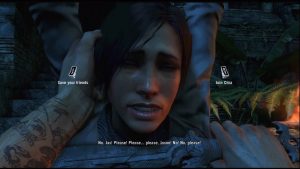
It might be tropical, but it’s no paradise. After a full game of grisly murder, growing your ability to commit violence, and one horrifying Deliverance-style scene, Jason makes it to the end of Far Cry 3’s story. He’s given two choices: save his friends, or join warrior goddess Citra. The choice comes with a price – either murder your friends to join Citra as a paragon of war, or deny the beautiful woman who has been one of the only allies you’ve had the whole game.
There’s a certain siren song to power. It calls to you, it makes you want to- oh, nevermind, you’re dead. Citra stabbed you. And after you murdered your friends for her. Ungrateful.
Would You Kindly – Bioshock
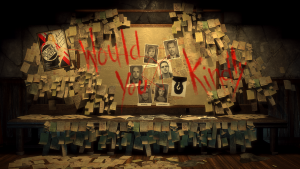
There’s always a lighthouse. There’s always a man. There’s always a city.
Two Bioshock games before that line blew our actually-the-villain-all-along (Hey! We mentioned that one already!) minds, a man desperate to save his family cheerfully asked us little favors. Who could deny his Irish charm? His manners? His brainwashing?
That’s right, Atlas, AKA Frank Fontaine, wasn’t some concerned family man helping you out all along – he was an agent of chaos, a villain, a man subtly directing main character/sleeper agent Jack’s every move with the phrase “Would you kindly.” He’s not your buddy, friend. He’s your enemy.
Or, as Andrew Ryan puts it: a man chooses. A slave obeys.
Killing the Archdemon – Dragon Age: Origins
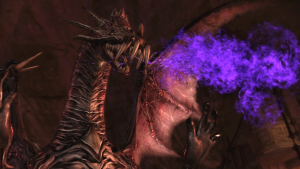
Dragon Age as a franchise loves to play with our minds. In Inquisition, everyone is a liar. In 2, no one can get their head out of their political agendas long enough to stop murdering each other. In Origins, saving the world isn’t as easy as just killing the big bad archdemon. In order to kill an archdemon, a Grey Warden must give his life. So while you and Alistair sit around drawing straws to see which one of you has to die, Morrigan has another idea.
All you have to do is knock her up — or have Alistair (again, who very well may be in a relationship with you) do the deed — and instead of killing the Grey Warden, the archdemon’s soul will go into her unborn child. Oh, but don’t worry — she’s going to take off immediately, and you won’t have to pay a dime of child support. Try not to think about the fact that she’s going to give birth to a baby with the soul of an old god hellbent on destroying the world.
The Death of Joker’s Sister – Mass Effect 3
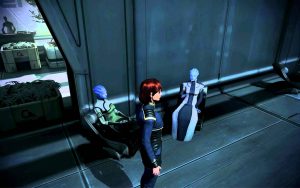
In Mass Effect 3, the whole galaxy is at war with the reapers. No planet is spared, and while Shepard and her team of elite warriors do what they can to save the worlds, they’re all quietly terrified for the people they’ve left at home.
Joker, pilot extraordinaire, romancer of robots, and maker of funny jokes, has a 15-year-old sister back on his home planet of Tiptree. Her name is Hilary. While visiting the Citadel throughout the course of the game, Shepard overhears snippets of a story told by an Asari commando named Aeian with PTSD. The story goes like this: she was on the planet of Tiptree, hanging out with a family on a farm and helping the population with evacuation. During this assignment, a banshee and an army of husks attacked. Aeian escaped with a little girl she had befriended – Hilary. They managed to stay safe for a while, but when they tried to retrieve a radio to call for help they were attacked and Hilary broke her leg. Scared and in pain, Hilary couldn’t stop crying. Aeian killed her in order to secure her own escape.
Later on, in a conversation between Joker and Liara, he finds out that most of the survivors from Tiptree were children. Joker quietly hopes this means he only lost his dad. Here’s the kicker: Aeian keeps asking for a gun. The decision to give her the gun is in Shepard’s hands. If you give her the gun, she will commit suicide.
Decisions, decisions.
Rape and Fire – Alice: Madness Returns
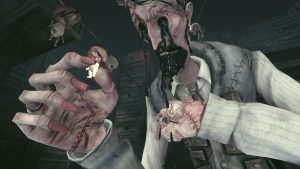
Alice in Wonderland is full of some truly weird stuff. Mental illness isn’t a new subject for the franchise, but American McGee’s Alice: Madness Returns takes the topic to a new level of dark. Having survived the events of the first game, Alice sees a psychiatrist named Dr. Bumby. Dr. Bumby uses hypnosis to try to cure Alice of her madness and hallucinations of Wonderland — or so we think. It turns out that Bumby was the villain who raped and murdered her sister Lizzie and started the fire that murdered her whole family in the first game.
It’s worse than that: the home Alice lives in where Bumby treats her is a place where Bumby grooms girls to be sold as sex slaves. Thank God Alice shoves him in front of an oncoming train.
The End of the World – Final Fantasy XIV
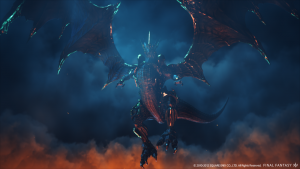
It’s no secret that the original version of Final Fantasy XIV flopped. Games like this usually need a dev team that’s both large and well-put-together. It takes experienced people from management to programmers to designers. FFXIV didn’t have a large team, which makes the lack of organization and leadership problematic. They couldn’t pull together a game that looked great, played smoothly, and kept fans coming back. They struggled to come together and release quality content. The reception was so poor that by the end, Squeenix made gameplay free – and that couldn’t even save it. So what do you do when your multi-million dollar MMO is a total flop? Destroy the world and start again.
In world-wide event, the Battle of Carteneau brought high level monsters and a red object in the sky that inched closer and closer until Bahamut himself broke free and murdered everything. The game stopped, the servers shut down. Every player died. It was all over.
Of course, after rigorous restructuring which included a new dev team helmed by Yoshi P (one of Squeenix’s rainmakers), the game launched again as Final Fantasy XIV: A Realm Reborn, which has now seen two expansions and almost as many subscribers as WoW boasted during its peak. Sometimes you have to watch the world burn in order to build a better one.
